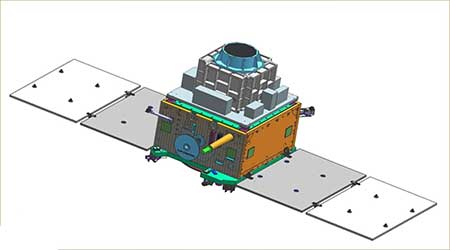Date : 29/05/2023
Relevance: GS-3: Science and Technology- developments and their applications and effects in everyday life.
Key Phrases: XPoSat, Polarimetry Mission, Indian Space Research Organisation, NASA, Raman Research Institute, X-Rays, Pulsars, Galactic Supernova Remnants, POLIX, XSPECT, Black Holes.
Context:
- The Indian Space Research Organisation is collaborating with the Raman Research Institute (RRI), Bengaluru, an autonomous research institute, to build the X-Ray Polarimeter Satellite (XPoSat) that is scheduled to be launched later this year.
Introduction
- According to ISRO, "XPoSat will study various dynamics of bright astronomical X-ray sources in extreme conditions”.
- It has been billed as India’s first, and only the world’s second polarimetry mission that is meant to study various dynamics of bright astronomical X-ray sources in extreme conditions.
- The other such major mission is NASA’s Imaging X-ray Polarimetry Explorer (IXPE) that was launched in 2021.
Understanding X-Rays in Space
- As NASA explains, X-rays have much higher energy and much shorter wavelengths, between 0.03 and 3 nanometers, so small that some X-rays are no bigger than a single atom of many elements.
- The physical temperature of an object determines the wavelength of the radiation it emits. The hotter the object, the shorter the wavelength of peak emission.
- X-rays come from objects that are millions of degrees Celsius — such as pulsars, galactic supernova remnants, and black holes.
The Significance of Polarimetry
- "Like all forms of light, X-rays consist of moving electric and
magnetic waves. Usually, peaks and valleys of these waves move in random
directions.
- Polarised light is more organised with two types of waves vibrating in the same direction," says a video from NASA on IXPE.
- It adds that fishermen use polarised lenses to reduce glare from sunlight when they are near water.
- The field of polarimetry studies the measurement of the angle of rotation of the plane of polarised light (that is, a beam of light in which the vibrations of the electromagnetic waves are confined to one plane) that results upon its passage through certain transparent materials, according to Britannica.
ISRO’s Efforts with XPoSat
- ISRO's website states that the emission mechanism from various astronomical sources such as black holes, neutron stars, active galactic nuclei, pulsar wind nebulae, etc. originates from complex physical processes and is challenging to understand.
- Space-based observatories are also unable to provide information about the exact nature of the emissions from such sources. Therefore, newer devices are required to measure specific properties.
XPoSat Payloads
- The spacecraft will carry two scientific payloads in a low Earth orbit. The primary payload, POLIX (Polarimeter Instrument in X-rays), will measure the polarimetry parameters (degree and angle of polarization).
- The payload is being developed by RRI in collaboration with ISRO's U
R Rao Satellite Centre (URSC) in Bengaluru.
- POLIX is expected to observe about 40 bright astronomical sources of different categories during the planned lifetime of XPoSat mission of about 5 years.
- This is the first payload in the medium X-ray energy band dedicated to polarimetry measurements.
- The XSPECT (X-ray Spectroscopy and Timing) payload will provide spectroscopic information (on how light is absorbed and emitted by objects). It would observe several types of sources, such as X-ray pulsars, black hole binaries, low-magnetic field neutron stars, etc.
Conclusion
- India's endeavour to launch the X-Ray Polarimeter Satellite (XPoSat)
marks a significant milestone in the country's space research efforts.
- With the collaboration between ISRO and the Raman Research Institute, the mission aims to study the dynamics of bright astronomical X-ray sources in extreme conditions.
- By utilizing polarimetry techniques, XPoSat will provide valuable
insights into the nature and behaviour of these celestial objects, including
black holes, neutron stars, and pulsars.
- The scientific payloads on board, POLIX and XSPECT, will enable detailed measurements of polarimetry parameters and spectroscopic information.
- As XPoSat prepares for its launch, it holds the promise of expanding our understanding of the universe and making notable contributions to the field of astrophysics.
Source: The Indian Express
Mains Question:
Q. Discuss the significance of India's X-Ray Polarimeter Satellite (XPoSat) mission in advancing the field of astrophysics. Explain the concept of polarimetry and how it enables a deeper understanding of bright astronomical X-ray sources. (150 words)







